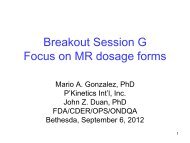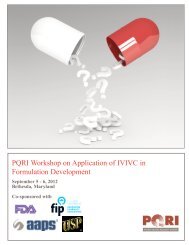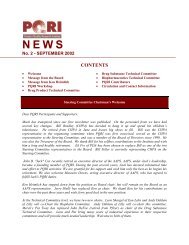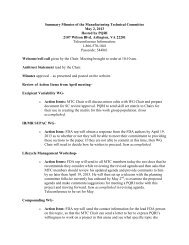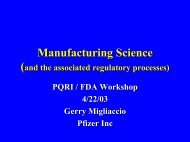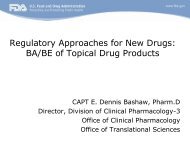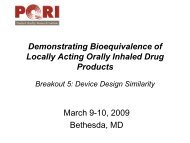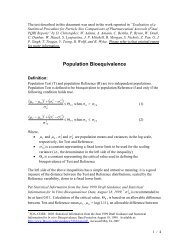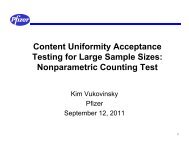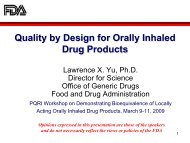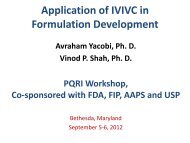BE of Topical Drug Products - PQRI
BE of Topical Drug Products - PQRI
BE of Topical Drug Products - PQRI
Create successful ePaper yourself
Turn your PDF publications into a flip-book with our unique Google optimized e-Paper software.
Regulatory Approaches for Generic<br />
<strong>Drug</strong>s: <strong>BE</strong> <strong>of</strong> <strong>Topical</strong> <strong>Drug</strong> <strong>Products</strong><br />
Barbara M. Davit, Ph.D., J.D.<br />
Director, Division <strong>of</strong> Bioequivalence II<br />
Office <strong>of</strong> Generic <strong>Drug</strong>s, CDER, FDA<br />
<strong>PQRI</strong> Workshop<br />
Evaluation <strong>of</strong> New and Generic <strong>Topical</strong> <strong>Drug</strong> <strong>Products</strong><br />
March 11-13, 2013
Agenda<br />
• Bioequivalence issues unique to topical<br />
drug products<br />
• Pharmacokinetic (PK) approach<br />
• Pharmacodynamic (PD) approach<br />
• Clinical approach<br />
• In vitro approach<br />
• Waiver <strong>of</strong> <strong>BE</strong> requirement (biowaiver)<br />
• Summary and conclusions<br />
2
Why do bioequivalence (<strong>BE</strong>)<br />
studies <strong>of</strong> topical products<br />
present unique regulatory issues?<br />
3
Why are <strong>BE</strong> studies necessary for<br />
proposed new generic products?<br />
• The US Code and FDA’s regulations require<br />
that a generic drug product be bioequivalent<br />
to its corresponding reference listed drug<br />
(RLD) product for marketing approval<br />
• It is not necessary to demonstrate safety and<br />
efficacy for the new generic<br />
– Relies on RLD safety and efficacy data<br />
• If certain criteria are met, FDA may grant a<br />
biowaiver<br />
4
Objective <strong>of</strong> <strong>BE</strong> studies in generic drug<br />
approval process<br />
• In an acceptable <strong>BE</strong> study, the generic and<br />
reference product should not show a significant<br />
difference in the rate and extent <strong>of</strong> availability at<br />
the site <strong>of</strong> action<br />
• FDA’s regulations list suitable <strong>BE</strong> approaches<br />
ranked by sensitivity, accuracy, reproducibility<br />
• For each new generic topical drug product, FDA<br />
must consider<br />
– The optimal <strong>BE</strong> approach; or<br />
– Whether a biowaiver is appropriate<br />
5
<strong>BE</strong> approaches, ordered by accuracy,<br />
sensitivity, reproducibility<br />
• PK<br />
• PD<br />
• Clinical endpoint<br />
• In vitro<br />
• Any other approach deemed<br />
suitable by FDA<br />
6
Considerations in selecting <strong>BE</strong> approach<br />
for a generic topical drug<br />
Site <strong>of</strong><br />
action<br />
Feasibility<br />
<strong>of</strong><br />
approach<br />
Choice <strong>of</strong> <strong>BE</strong> study<br />
design depends on<br />
ability to compare<br />
drug delivered by<br />
generic & RLD at site<br />
<strong>of</strong> action<br />
Mechanism<br />
<strong>of</strong> action<br />
Sensitivity<br />
<strong>of</strong><br />
approach<br />
RLD<br />
formulation<br />
7
Some definitions applied in comparing<br />
generic and RLD topical formulations<br />
Terminology<br />
Abbr. Definition<br />
Qualitatively the<br />
same<br />
Quantitatively the<br />
same<br />
Physicochemical<br />
attributes <strong>of</strong> a<br />
topical dosage form<br />
Q1<br />
Q2<br />
Q3<br />
Generic and RLD products<br />
contain the same active and<br />
inactive ingredients<br />
Generic and RLD products<br />
contain the same amounts <strong>of</strong><br />
active and inactive ingredients<br />
Generic and RLD products<br />
have the same<br />
physicochemical properties<br />
8
Several case studies illustrate how<br />
FDA determines an appropriate <strong>BE</strong><br />
approach for a generic topical<br />
product<br />
9
Application <strong>of</strong> PK approach:<br />
lidocaine topical patch 5%<br />
10
Application <strong>of</strong> PK approach:<br />
lidocaine topical patch 5%<br />
<strong>Drug</strong><br />
substance<br />
• An amidetype<br />
local<br />
anesthetic<br />
agent<br />
Indication<br />
• Relief <strong>of</strong><br />
pain<br />
associated<br />
with postherpetic<br />
neuralgia<br />
Mechanism<br />
<strong>of</strong> action<br />
• Lidocaine<br />
acts on<br />
nerves in<br />
dermal<br />
tissue<br />
11
Application <strong>of</strong> PK approach:<br />
lidocaine topical patch 5%<br />
Site <strong>of</strong> action<br />
• Lidocaine<br />
penetrates<br />
beneath the<br />
stratum<br />
corneum to<br />
reach the site<br />
<strong>of</strong> action in<br />
dermal tissue<br />
RLD<br />
formulation<br />
• An adhesive<br />
material<br />
containing<br />
5% lidocaine,<br />
to be applied<br />
to the skin<br />
Sensitivity,<br />
feasibility<br />
• Lidocaine in<br />
plasma is<br />
proportional<br />
to its<br />
presence at<br />
site <strong>of</strong> action<br />
• Measuring<br />
lidocaine in<br />
plasma is<br />
feasible<br />
12
Application <strong>of</strong> PD approach:<br />
fluocinolone acetonide 0.01%<br />
topical body oil<br />
13
Application <strong>of</strong> PD approach:<br />
fluocinolone acetonide topical oil<br />
<strong>Drug</strong> substance<br />
• Low-to-medium<br />
range potency<br />
corticosteroid<br />
Indication<br />
• <strong>Topical</strong><br />
treatment <strong>of</strong><br />
atopic dermatitis<br />
Mechanism <strong>of</strong><br />
action<br />
• Has antiinflammatory,<br />
antipruritic, &<br />
vasoconstrictive<br />
properties<br />
14
Application <strong>of</strong> PD approach:<br />
fluocinolone acetonide topical oil<br />
Site <strong>of</strong> action<br />
• Absorbed<br />
percutaneously;<br />
not intended to<br />
be systemically<br />
absorbed<br />
RLD formulation<br />
• A solution <strong>of</strong><br />
fluocinolone<br />
acetonide in a<br />
blend <strong>of</strong> oils<br />
Sensitivity,<br />
feasibility<br />
• The PD<br />
vasoconstrictor<br />
assay can<br />
accurately<br />
detect rate and<br />
extent <strong>of</strong><br />
availability in<br />
skin<br />
15
Fluocinolone acetonide topical oil:<br />
additional considerations for <strong>BE</strong><br />
16
Application <strong>of</strong> clinical endpoint<br />
approach: 5-flourouracil<br />
(5-FU) cream 5%<br />
17
Application <strong>of</strong> clinical approach:<br />
5-FU cream 5%<br />
<strong>Drug</strong> substance<br />
• A fluoropyrimidinedione<br />
which is<br />
cytotoxic<br />
Indication<br />
• <strong>Topical</strong><br />
treatment <strong>of</strong><br />
actinic<br />
keratoses (AK)<br />
• Treatment <strong>of</strong><br />
superficial<br />
basal cell<br />
carcinomas<br />
(sBCC)<br />
Mechanism <strong>of</strong><br />
action<br />
• Creates a<br />
thymine<br />
deficiency,<br />
provoking<br />
unbalanced<br />
growth in<br />
rapidly-growing<br />
cells, such as<br />
carcinomas<br />
18
Application <strong>of</strong> clinical approach:<br />
Site <strong>of</strong> action<br />
5-FU cream 5%<br />
RLD formulation<br />
Sensitivity,<br />
feasibility<br />
• Acts on AK and<br />
sBCC lesions in<br />
the epidermis<br />
and dermis<br />
• Cream contains<br />
5-FU in a<br />
vanishing cream<br />
base comprised<br />
<strong>of</strong> several<br />
inactive<br />
ingredients<br />
• AK treatment is<br />
considered more<br />
sensitive to<br />
formulation<br />
performance<br />
than sBCC<br />
treatment<br />
• It is feasible to<br />
perform a<br />
clinical endpoint<br />
<strong>BE</strong> study in AK<br />
patients<br />
19
Clinical endpoint <strong>BE</strong> studies <strong>of</strong> 5-<br />
FU: additional considerations<br />
• Primary endpoint is proportion <strong>of</strong> subjects with<br />
treatment success at study week 6<br />
• Success is defined as 100% clearance <strong>of</strong> all<br />
AK lesions within the treatment area<br />
• A placebo control arm is recommended to<br />
– Demonstrate that the generic and RLD are active;<br />
– As a parameter to show that study is sufficiently<br />
sensitive to detect differences between products<br />
20
Application <strong>of</strong> in vitro approach:<br />
acyclovir ointment 5%<br />
21
An in vitro approach can be used for<br />
<strong>Drug</strong><br />
substance<br />
• A synthetic<br />
nucleotide<br />
analogue<br />
active against<br />
herpes<br />
viruses<br />
acyclovir ointment 5%<br />
Indication<br />
• Initial<br />
outbreaks <strong>of</strong><br />
genital<br />
herpes<br />
• Treat certain<br />
types <strong>of</strong><br />
lesions<br />
caused by<br />
Herpes<br />
simplex virus<br />
Mechanism <strong>of</strong><br />
action<br />
• Converted to<br />
acyclovir<br />
triphosphate<br />
intracellularly<br />
• Acyclovir<br />
triphosphate<br />
stops<br />
replication <strong>of</strong><br />
herpes viral<br />
DNA<br />
22
An in vitro approach can be used for<br />
acyclovir ointment 5%<br />
Site <strong>of</strong> action<br />
• Acyclovir<br />
delivered by the<br />
ointment<br />
functions in the<br />
upper layer <strong>of</strong><br />
the skin<br />
RLD formulation<br />
• Considerably<br />
less complex<br />
than a cream<br />
• Consists <strong>of</strong> one<br />
active ingredient<br />
suspended in a<br />
polyethylene<br />
glycol base<br />
Sensitivity,<br />
feasibility<br />
• An in vitro <strong>BE</strong><br />
approach more<br />
sensitive than a<br />
clinical endpoint<br />
<strong>BE</strong> study<br />
• Due to low<br />
potency <strong>of</strong><br />
ointment, a<br />
clinical endpoint<br />
<strong>BE</strong> study may<br />
not be feasible<br />
or reliable<br />
23
<strong>BE</strong> <strong>of</strong> acyclovir ointment 5%:<br />
additional considerations<br />
• The generic and RLD products must be Q1/Q2<br />
• To show that generic and RLD are also Q3,<br />
conduct in vitro tests to compare<br />
– Release rates<br />
– Particle size, viscosity, morphic form, PEG<br />
molecular weight distribution<br />
• If not Q1/Q2, conduct clinical endpoint study<br />
24
For the dicl<strong>of</strong>enac sodium gel 1%,<br />
FDA recommends a PK endpoint<br />
study and a clinical endpoint<br />
study to demonstrate <strong>BE</strong><br />
25
For dicl<strong>of</strong>enac sodium gel 1%, FDA<br />
recommends two in vivo <strong>BE</strong> studies<br />
<strong>Drug</strong> substance<br />
• Non-steroidal<br />
antiinflammatory<br />
Indication<br />
• Relief <strong>of</strong> the<br />
pain <strong>of</strong><br />
osteoarthritis<br />
Mechanism <strong>of</strong><br />
action<br />
• Inhibits<br />
cyclooxygenase,<br />
resulting in<br />
decreased<br />
synthesis <strong>of</strong><br />
molecules<br />
associated with<br />
inflammatory<br />
response<br />
26
For dicl<strong>of</strong>enac sodium gel 1%, FDA<br />
recommends two in vivo <strong>BE</strong> studies<br />
Site <strong>of</strong> action<br />
• The joint or local<br />
s<strong>of</strong>t tissue<br />
• Dicl<strong>of</strong>enac<br />
penetrates the<br />
s<strong>of</strong>t tissue<br />
• Dicl<strong>of</strong>enac is also<br />
well-absorbed<br />
• Unclear if effects<br />
are due solely to<br />
local delivery or if<br />
systemic delivery<br />
contributes<br />
RLD formulation<br />
• A gel comprised <strong>of</strong><br />
several different<br />
inactive<br />
ingredients<br />
Sensitivity,<br />
feasibility<br />
• A PK study is<br />
most sensitive,<br />
accurate,<br />
reproducible but<br />
may be unsuitable<br />
if drug acts mainly<br />
by local action<br />
• As there is<br />
evidence that drug<br />
may be locallyacting,<br />
an in vivo<br />
study with clinical<br />
endpoints should<br />
also be conducted<br />
27
The FDA will consider granting<br />
biowaivers for topical products<br />
provided certain criteria are met<br />
28
Criteria for granting a biowaiver for a<br />
topical solution<br />
• Formulation is a solution for application to skin;<br />
• Generic and RLD contain the same active<br />
ingredient in the same concentration and<br />
dosage form;<br />
• The generic contains no inactive ingredient or<br />
other change in formulation from the RLD that<br />
might significantly affect availability<br />
– e.g, FDA may request in vivo and/or in vitro <strong>BE</strong> studies if<br />
generic and RLD have differences in penetration enhancers<br />
29
Biowaivers for products coded “AT”<br />
in FDA’s Orange Book<br />
• Applies to very few topical formulations<br />
approved prior to 1962<br />
• Underwent review by the <strong>Drug</strong> Efficacy Study<br />
Implementation (DESI) panels <strong>of</strong> experts<br />
• Generic and RLD must contain same active<br />
ingredient and be <strong>of</strong> same dosage form<br />
• Examples<br />
– Erythromycin topical gel<br />
– Hydrocortisone topical cream<br />
30
Summary and conclusions<br />
• FDA determines the optimal <strong>BE</strong> approach for<br />
each proposed generic topical formulation on<br />
a case-by-case basis<br />
• Approach may be PK, PD, clinical, in vitro<br />
• In determining the optimal <strong>BE</strong> approach for<br />
each product, FDA considers<br />
– <strong>Drug</strong> mechanism <strong>of</strong> action, site <strong>of</strong> action<br />
– Complexity <strong>of</strong> RLD formulation<br />
– Feasibility, sensitivity <strong>of</strong> an approach<br />
31
References<br />
• http://www.accessdata.fda.gov/scripts/cder/drugsatfda/index.cfm<br />
o Voltaren® gel, NDA 22122<br />
• http://www.accessdata.fda.gov/scripts/cder/ob/default.cfm<br />
o Electronic Orange Book<br />
• http://www.fda.gov/<strong>Drug</strong>s/GuidanceComplianceRegulatoryInformation/Gui<br />
dances/ucm075207.htm<br />
o Bioequivalence Recommendations Guidance for the dicl<strong>of</strong>enac<br />
sodium topical gel, 1% strength<br />
• http://www.regulations.gov<br />
o Acyclovir ointment 5%, Docket No. FDA-2012-P-0779<br />
o Fluocinolone acetonide topical oil 0.01%, Docket No. FDA-2004-P-<br />
0215<br />
o Fluorouracil cream, Docket No. 2004P-0557/CP1<br />
o Lidocaine patch 5%, Docket No. FDA-2006-P-0356<br />
o 21 CFR Section 320.22 (biowaivers)<br />
32
Acknowledgements<br />
• Josephine Aimiuwu<br />
• Shawn Blue<br />
• April Braddy<br />
• Parthapratim Chandaroy<br />
• Dale Conner<br />
• Kuldeep Dhariwal<br />
• Brenda Gierhart<br />
• Tapash Ghosh<br />
• Yih-Chain Huang<br />
• Loice Kikwai<br />
• Rob Lionberger<br />
• Steve Miller<br />
• Jeff Murray<br />
• Cecelia Parise<br />
• John Peters<br />
• Kimberly Raines<br />
• Andre Raw<br />
• Shirley Seo<br />
• Aaron Sigler<br />
• Ethan Stier<br />
• Scott Vehovic<br />
• Keith Webber<br />
33
Thank you for your attention!<br />
34



